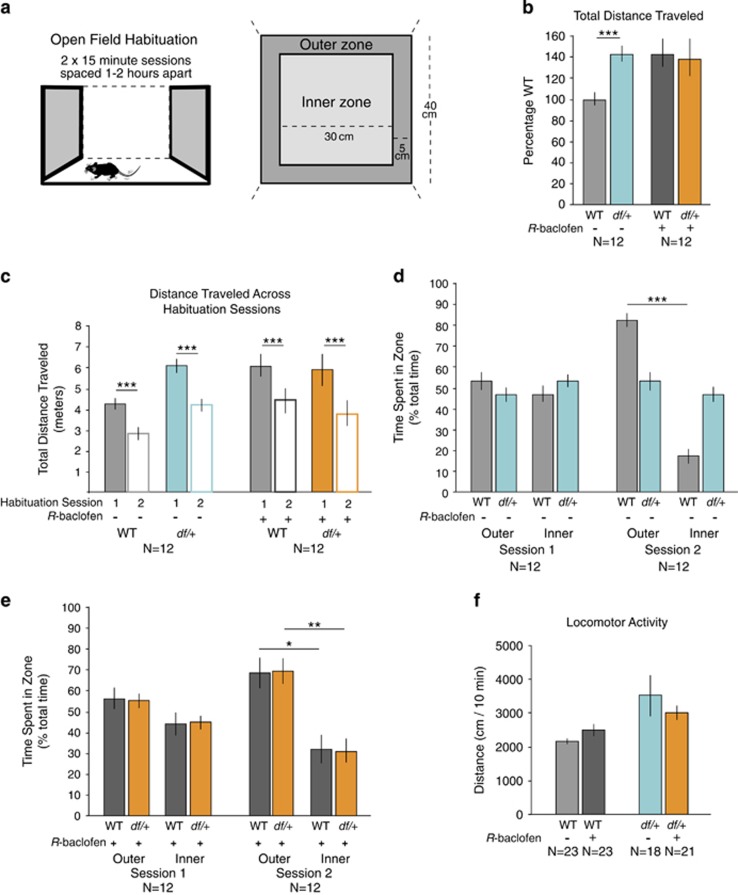Figure 3.
16p11.2 df/+ mice show habituation deficits in an open field task, which is reversed by chronic R-baclofen treatment. (a) Experimental design of open field habituation task. (b) 16p11.2 df/+ mice treated with vehicle show statistically significant hyperactivity compared with WT animals treated with vehicle in the open field as indicated by distance traveled over the course of both habituation sessions (veh vs df/+ veh: t(22)=4.33, p<0.001). WT animals treated with R-baclofen show significantly increased locomotion compared with vehicle-treated animals (WT veh vs R-baclofen: t(22)=2.89, p<0.01). There is no statistical significance between: 16p11.2 df/+ animals treated with vehicle or R-baclofen (df/+ veh vs R-baclofen: t(22)=0.248, p=0.807; WT); WT animals treated with R-baclofen and 16p11.2 heterozygous animals treated with vehicle (df/+ veh vs WT R-baclofen: t(22)=0.010, p=0.992) or WT animals and 16p11.2 heterozygous treated with R-baclofen (WT R-baclofen vs df/+ R-baclofen: t(22)=0.206, p=0.839). (c) Across genotypes and treatments, animals travel a greater distance in the first habituation session compared with the second habituation session (WT veh, session 1 vs session 2: t(11)=6.85, p<0.001; df/+ veh, session 1 vs session 2: t(11)=9.58, p<0.001; WT R-baclofen, session 1 vs session 2: t(11)=4.81, p<0.001; df/+ R-baclofen, session 1 vs session 2: t(11)=4.56, p<0.001. (d) Vehicle-treated WT and 16p11.2 df/+ mice exhibit similar behavior during the first habituation session. During the second session, WT mice spend significantly more time in the outer zone of the arena, whereas 16p11.2 df/+ mice do not spend significantly more time in either the inner or outer zones of the arena (WT vs df/+, Session 1—outer zone, t(22)=1.32, p=0.201; WT vs df/+, Session 1—inner zone, t(22)=1.32, p=0.201; WT vs df/+, Session 2—outer zone, t(22)=5.83, p<0.001; WT vs df/+, Session 2—inner zone, t(22)=5.83, p<0.001; WT, Session 1, inner vs outer, t(11)=0.782, p=0.450; df/+, Session 1, inner vs outer, t(11)=1.13, p=0.281; WT, Session 2, inner vs outer, t(11)=9.90, p<0.001; df/+, Session 2, inner vs outer, t(11)=0.820, p=0.430). Three-way genotype × zone × session: F(7,88)=16.867, p<0.001). Pairwise multiple comparison procedures (Holm–Sidak method): genotype within session 1, WT vs df/+: t=0.00005, p=1.00; zone within session 1, inner vs outer: t=0.131, p=0.896; genotype within inner—session 2, WT vs df/+: t=5.82, p<0.001; genotype within outer—session 2, WT vs df/+: t=5.82, p<0.001; zone within WT, session 2: t=12.9, p<0.001; zone within df/+, session 2: t=1.24, p=0.218. (e) R-baclofen-treated WT and 16p11.2 df/+ mice exhibit similar behavior during the first habituation session. During the second session, both WT mice and 16p11.2 df/+ mice spend significantly more time in the outer zone of the arena (WT vs df/+, session 1—outer zone, t(22)=0.142, p=0.889; WT vs df/+, session 1—inner zone, t(22)=0.142, p=0.889; WT vs df/+, session 2—outer zone, t(22)=0.106, p=0.917; WT vs df/+, session 2—inner zone, t(22)=0.106, p=0.917; WT, Session 1, inner vs outer, t(11)=1.21, p=0.252; df/+, Session 1, inner vs outer, t(11)=1.60, p=0.138; WT, Session 2, inner vs outer, t(11)=2.56, p=0.026; df/+, Session 2, inner vs outer, t(11)=3.19, p<0.01). Three-way genotype × zone × session: F(7,88)=0.055, p=0.814). (f) Dolmetsch 16p11.2 df/+ mice in UCD lab: Total distance traveled was recorded using the Noldus Ethovision software. No significant effect of drug treatment was detected on exploratory activity during a 10-min open field session in the same chambers used for the object location memory task. One-way ANOVA (F(3,81)=3.22; p=0.027, Tukey’s multiple comparison test p=0.027 for the comparison of WT vehicle vs df/+ vehicle only. *p<0.05, **p<0.01, ***p<0.001, R-baclofen vs vehicle within genotype.

